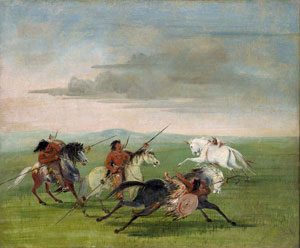
History of archery: Khoisan rock painting from South Africa
African invention of the bow and arrow
People in Africa invented hunting bows and arrows, probably about 64,000 years ago. Some of the earliest arrowheads come from South Africa.
More about hunting
African science and inventions
All our Africa articles
As people spread from Africa to India, Australia, all over Asia, and Europe, they took their bows and arrows with them. People in Australia seem to have forgotten about the hunting bow and arrow, but people did use bows and arrows all over Asia, Africa, and Europe.
(Really shooting an arrow, but you can see it really well here)
How does archery work?
A bow and arrow is a kind of lever. It’s a third-class lever, where the fulcrum is one end of the bow, the force is your hand pulling the bow in the middle, and the weight is the other end of the bow.
More about types of lever
What are wedges?
The arrows are wooden sticks fletched with feathers stuck to the ends to balance the arrows and help them to fly in a straight line. An arrow is a kind of wedge. Bows can be made of one stick of wood, if you have the right kind of wood, but people can make better bows by gluing together a lot of smaller pieces of wood.
It’s easy to learn to hit the target, but to be as good as professional soldiers in early armies were, you need years of lessons and practice to build the right muscles. Because it took so long to train good archers, only the richest countries could afford to have companies of archers – or places where hunting was part of everyday life, like Central Asia.

Two hunters with bows (Kerch, on the Black Sea, ca. 400 BC)
Central Asian people invented the composite bow
To make a strong bow out of wood, it has to be pretty long – nearly as tall as a person. When people began to ride horses in Central Asia, about 2500 BC, these long bows got in their way. So about this time, somebody in Central Asia invented the stronger, more flexible composite bow.
More about riding horses
The composite bow is made of layers of wood, animal horns, and sinew, glued together in layers (usually a layer of sinew, then wood in the middle, then horn on the other side), and you can bend it a lot farther without breaking it, so you can shoot arrows with a shorter bow that will fit better on your horse.
Gradually the invention spread: by 1300 BC, Egyptian soldiers were also riding horses and using composite bows, and by about 300 BC Chinese soldiers were using composite bows.
Central Asians also invented the recurve bow

Iranian archers with recurve bows (Susa, 500 BC)
Later on, maybe around 1000 BC, these same horse riding archers in Central Asia invented the recurve bow. These bows were in the shape of a wide W, which can shoot further for the same length of bow.
The use of recurve bows quickly spread from Central Asia to China. The Persians (Iranians) may have brought the recurve bow to West Asia, and from there to the Egyptians, Phoenicians and Greeks, who spread it to the Romans and Carthaginians in Africa.
Crossbow invented in China
Soon after the recurve bow came to China, about 450 BC, Chinese blacksmiths invented the crossbow. Crossbows, which had an iron catch added, allowed you to draw the bow, getting it all ready to shoot, and then stop it there, so you could shoot just by releasing the catch.
Chinese science and inventions
These early crossbows didn’t have cranks yet; you drew the bow by hooking it to your belt and straightening your legs to pull it.
Hand cranks added to crossbows
Roman hunters had learned about crossbows by around 50 AD, and soldiers in the Abbasid empire were using crossbows before 900 AD.By this time, a mechanical crank let you draw the bow much harder than your muscles could alone, which allowed you to shoot much farther than with a regular bow.
More about the invention of cranks
In the Middle Ages, many archers in Europe used crossbows. Even in the Middle Ages, though, archers in England, France, and Germany often used all-wood longbows instead of recurve composite bows or crossbows. Longbows lasted better in wet weather, and these archers weren’t riding horses anyway. So the history of archery isn’t always directly from one new invention to another.
History of archery in North America

George Catlin, Comanche riding horses (1834)
Even though bows and arrows already existed by the time Central Asian people first crossed over to North America, those people don’t seem to have known about them: the earliest people living in North America didn’t use bows and arrows.
But around 3000 BC, people in North America started to use hunting bows and arrows. Probably they got their bow technology from the Tuniit, and it spread from there across the Americas.
The recurve bow in North America
By about 500 AD, East Asian traders brought the recurve bow (though not the crossbow and crank) to the Inuit in northern North America. Around 500 AD, the Inuit probably brought the recurve bow to the Americas, because many Native people, especially on the West Coast, also used recurve bows.
Who were the Inuit?
Because people in North America didn’t ride horses, they didn’t need composite bows. Some bow-makers did still use sinew on their hunting bows. Then as soon as North American people got horses (by seizing them from Spanish colonizers in the late 1600s), the Native Americans started to invent shorter composite bows. But by the late 1800s, guns had improved enough that bows and arrows pretty much went out of use.
More about the history of guns
Did you find out what you wanted to know about the history of archery? Let us know in the comments!
Learn by doing: archery project
More about early weapons: atlatls
Bibliography and further reading about bows and arrows:




The indigious ppl of oz were still stone age until the white man came in the 16 17th century.,,,
Yes, but they were alive, and thriving, not sickened by white people’s diseases or locked up in white people’s jails.
[…] Read complete history of bow hunt https://quatr.us/african-history/invented-bow-arrow.htm […]
Great article, very informative. The only thing I don’t agree with is that it is not that hard to learn how to use a bow and arrow, one can hit a target fairly accurately with a few weeks practice. What is extremely difficult is making both the bow and the arrow. It takes great skill and knowledge of materials and use of tools and experience to make an arrow or a bow. They were one of humanity’s most important Inventions.
Thank you! Yes, it only takes a little while to hit a target, but developing the muscles and skill of a medieval English longbow archer took at least a decade of practice, as we know from people writing about it at the time. This was a big concern, because training the archers the country needed for its army was very expensive. I’ve edited the article to make that more clear. Thanks for the suggestion!
Thank you
This was exactly the information I was looking for.
Hi Anthony, Wonderful! I’m glad we could help.
I would’ve thought that the bow and arrow would have come on the scene much earlier
It’s possible that archery was invented earlier, but there’s no evidence of it. And, against that idea, Native Americans do not seem to have brought bows and arrows with them when they crossed to the Americas about 13,000 BC. It’s possible that bows and arrows were an invention of the end of the Ice Age, when most of the larger animals went extinct and people turned to hunting smaller animals like deer and rabbits.
[…] the invention of bows sometimes in 1960, it has been subjected to timely changes and modern innovations that has made it […]
I am wondering did they use bow and arrows at Mesopotamia
Yes, they did. Check out this page: http://factsanddetails.com/world/cat56/sub363/item1516.html
you did one on bows and arrows
am an archery my self
I am curious about the statement that east Asian traders were in contact with North America around 500 AD. Were they coming to Alaska or Canada?
They are probably following the coastline, not sailing out of sight of land. So they would get to Alaska rather than Canada.
thanks!!!
This helped me in my research. Many thnaks for sharing this.
Glad we could help!
Do you ave any sources for any or all of this information? If so, what are they?
Some sources where you can find this same information are listed in the bibliography at the end of this article.
Re my comment regarding indigenous Australian use of archery, I did mean they occupied Aust for between 40 and 65 thousand years, not million as written, apologies.
However gist and non-use detail remains the same.
… Peter White
You are quite correct that there is no evidence that any humans in Australia ever used bows and arrows. But the earlier people from whom the Australian aborigines descended did have bows and arrows, so aborigines must have forgotten the use of them, either before or after they arrived in Australia.
Hi Professor Carr,
I am writing to comment on part of this page about the history of archery. Thank you for providing the interesting details that you do.
But you are incorrect in your opening para regarding prehistoric people’s taking the bow and arrow concept to Australia in particular. I am only a casual researcher into the culture of Indigenous Australians but it is well known here (Australia) that bows and arrows were never used by Australian Aborigines, nor blowpipes, nor in fact any weapon that uses projectiles.
Only objects physically thrown by hand, spears, boomerangs, throwing clubs, etc, were ever used during the estimated 40 – 65 million years that they maintained what was basically a Stone Age culture and existence.
Many questions are raised in my mind about that fact.., that in tens of millions of years occupying all of Australia with all its diverse climates and vegetations, NO-ONE had the innovation to create bow and arrow hunting!!
They did develop incredibly complex family and social structures, well worth reading about.
Regards… Peter White. 13 Chapel St, Dalton NSW 2581, Australia.
” they took their bows and arrows with them. People in Australia seem to have forgotten about the hunting bow and arrow, but people did use bows and arrows all over Asia, Africa, and Europe.” this is what she said down to the word not once did she say that Australians used the bow